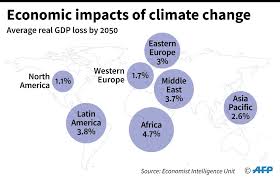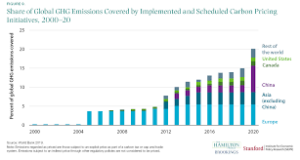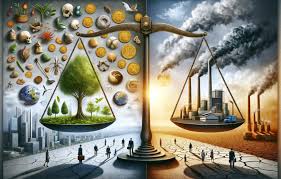The Economic Impact of Climate Change: Challenges and Opportunities
Climate change is not only an environmental crisis but also a profound economic challenge that affects every aspect of society. Its implications range from direct physical impacts on infrastructure and productivity to more complex interactions with global markets, health systems, and social structures. Understanding the economic impact of climate change is essential for policymakers, businesses, and communities as they navigate the transition to a more sustainable and resilient future. This essay explores the various economic dimensions of climate change, its costs, impacts on different sectors, and the potential for economic opportunities through mitigation and adaptation strategies.
Understanding Climate Change and Its Economic Repercussions
What is Climate Change?
Climate change refers to long-term alterations in temperature, precipitation, wind patterns, and other elements of the Earth’s climate system, primarily driven by human activities. The burning of fossil fuels, deforestation, and industrial processes have led to increased concentrations of greenhouse gases (GHGs) in the atmosphere, resulting in global warming and associated climatic shifts.
The Economic Costs of Climate Change
The economic costs of climate change can be categorized into several areas:
- Physical Damage: This includes the costs associated with damage to infrastructure, homes, and businesses due to extreme weather events such as hurricanes, floods, droughts, and wildfires. The increasing frequency and intensity of these events are expected to lead to significant economic losses.
- Agricultural Productivity: Climate change impacts agricultural yields through shifts in temperature and precipitation patterns, pest dynamics, and increased frequency of extreme weather events. These changes can lead to food insecurity, increased prices, and economic instability, especially in developing countries that rely heavily on agriculture.
- Health Costs: Climate change can exacerbate health issues through increased heat-related illnesses, respiratory problems due to air pollution, and the spread of vector-borne diseases. These health impacts impose additional costs on healthcare systems and reduce productivity due to illness.
- Water Scarcity: Changes in precipitation patterns and increased evaporation due to higher temperatures can lead to water shortages, affecting agriculture, industry, and human consumption. The economic costs of managing water scarcity and investing in infrastructure to ensure access to clean water can be substantial.
- Energy Costs: The energy sector is directly impacted by climate change, with changes in supply and demand dynamics. Increased temperatures can lead to higher energy consumption for cooling, while extreme weather events can disrupt energy supply chains.
- Insurance and Risk Management: As the frequency of natural disasters increases, insurance companies face rising claims, leading to higher premiums and potentially uninsurable risks. This can create economic instability and discourage investment in vulnerable areas.
Quantifying the Economic Costs
Quantifying the economic impact of climate change is challenging due to the complexity of interactions across different sectors and the long time frames involved. However, numerous studies have attempted to estimate these costs:
- The Stern Review: This landmark report by economist Nicholas Stern in 2006 estimated that climate change could cost the global economy up to 20% of GDP if no action is taken. Conversely, taking action to mitigate climate change could cost around 1% of GDP.
- The Intergovernmental Panel on Climate Change (IPCC): The IPCC’s assessments indicate that the costs of climate change impacts could reach trillions of dollars annually by the end of the century if current trends continue. These estimates include both direct costs and the indirect costs associated with loss of productivity and well-being.
- National and Regional Studies: Various countries and regions have conducted their analyses, with findings suggesting that developing countries may face the most significant economic impacts, exacerbating existing inequalities.
Sector-Specific Impacts of Climate Change
- Agriculture

Agriculture is particularly vulnerable to climate change due to its dependence on weather patterns.
- Crop Yields: Rising temperatures and changing precipitation patterns can lead to reduced crop yields. For example, staple crops such as wheat, rice, and maize may see declines in productivity in many regions, especially in low-latitude countries.
- Food Prices: Decreased agricultural output can lead to higher food prices, affecting food security for vulnerable populations. The World Bank estimates that climate change could push over 100 million people into extreme poverty by 2030 due to food price shocks.
- Farming Practices: Farmers may need to adapt their practices, leading to increased costs associated with research, technology adoption, and potential changes in crop selection.
- Infrastructure
Infrastructure is at risk from climate change impacts, including flooding, erosion, and heat stress.
- Damage Costs: The costs associated with repairing and maintaining infrastructure in the face of climate impacts can be substantial. For example, the American Society of Civil Engineers estimates that the U.S. will need to invest approximately $4.5 trillion by 2025 to improve and adapt its infrastructure.
- Long-Term Resilience: Investing in resilient infrastructure—such as flood defenses, heat-resistant buildings, and upgraded transportation networks—requires upfront costs but can save money in the long run by reducing damage from climate-related events.
- Energy
The energy sector is directly impacted by climate change and also plays a critical role in greenhouse gas emissions.
- Supply Disruptions: Extreme weather events can disrupt energy production and distribution, leading to increased costs and economic instability. For example, hurricanes can damage oil rigs and refineries, while droughts can reduce hydropower output.
- Transition to Renewables: The shift towards renewable energy sources, while essential for reducing emissions, requires significant investment. However, transitioning to renewables can create jobs and stimulate economic growth in the long run.
- Health

The economic implications of climate change on health are substantial.
- Healthcare Costs: Increased heatwaves, pollution, and the spread of diseases can lead to rising healthcare costs. For example, the CDC estimates that heat-related illnesses alone could cost the U.S. billions annually.
- Productivity Loss: Illness and health issues can reduce workforce productivity, leading to economic losses. A study by the National Bureau of Economic Research found that heat exposure could reduce labor productivity by up to 20% in outdoor sectors.
- Insurance and Risk Management
The insurance sector is directly affected by climate change, facing increasing claims due to natural disasters.
- Rising Premiums: As risks increase, insurance companies may raise premiums or withdraw coverage in high-risk areas, making it difficult for residents and businesses to insure properties.
- Financial Stability: The accumulation of unmanageable risks can threaten the financial stability of insurance companies and increase the costs of doing business in vulnerable areas.
Economic Opportunities Arising from Climate Action
While climate change presents numerous economic challenges, it also offers opportunities for innovation, job creation, and sustainable growth.
- Green Jobs and Sustainable Industries
Transitioning to a low-carbon economy can create millions of jobs in renewable energy, energy efficiency, and sustainable practices.
- Renewable Energy Sector: The International Renewable Energy Agency (IRENA) estimates that the renewable energy sector employed over 11 million people worldwide in 2018, with potential for further growth as investment in renewables continues.
- Energy Efficiency Jobs: The energy efficiency sector also presents significant job opportunities in retrofitting buildings, improving insulation, and implementing smart technologies.
- Innovation and Technology Development

The need to address climate change drives innovation in technology and business practices.
- Clean Technology: Investments in clean technology research and development can lead to breakthroughs that not only mitigate climate impacts but also enhance competitiveness in global markets.
- Circular Economy: Shifting towards a circular economy, where resources are reused and recycled, can create new business models and economic opportunities.
- Resilient Infrastructure Investments
Investing in climate-resilient infrastructure can provide immediate economic benefits while preparing for future climate impacts.
- Job Creation: Infrastructure projects create jobs and stimulate local economies. For example, building resilient infrastructure, such as flood defenses or energy-efficient buildings, can provide a significant boost to construction and related industries.
- Long-Term Savings: Resilient infrastructure reduces vulnerability to climate impacts, leading to long-term savings in repair and maintenance costs.
- Enhanced Public Health Outcomes
Addressing climate change can lead to improved public health, which in turn has positive economic implications.
- Reduced Healthcare Costs: By mitigating climate change, we can reduce the incidence of heat-related illnesses, respiratory diseases, and other health issues, leading to lower healthcare expenditures.
- Increased Productivity: A healthier workforce is more productive, contributing positively to economic growth.
- International Collaboration and Funding
Addressing climate change presents opportunities for international cooperation and investment.
- Climate Finance: Investments in climate adaptation and mitigation are increasingly being recognized as essential by financial institutions, leading to the emergence of green bonds and climate-focused investment funds.
- Global Partnerships: Collaborative international efforts can enhance resource sharing, technology transfer, and capacity building, particularly in developing countries that are often the most vulnerable to climate impacts.
Conclusion
The economic impact of climate change is profound, affecting multiple sectors and leading to significant costs. However, alongside these challenges lie substantial opportunities for innovation, job creation, and sustainable growth.
Addressing climate change requires a comprehensive approach that incorporates both mitigation and adaptation strategies. By investing in green technologies, resilient infrastructure, and sustainable practices, we can not only combat climate change but also foster a more equitable and prosperous economy. Policymakers, businesses, and communities must work together to create a sustainable future that recognizes the interconnectedness of climate action and economic resilience. The transition to a low-carbon economy is not merely a necessity for environmental health but also a pathway to economic stability and growth.

